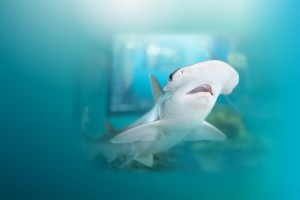
Aquarium Sciences: Fish & Invertebrates
Internship: Mote's Aquarium Sciences and Animal Care team, Fish & Invertebrate Department
1600 Ken Thompson Parkway
Sarasota, FL 34236
Ph: (941) 388-4441
Hours: 10AM - 5PM
A 501(c)3 nonprofit organization.
Mote Marine Laboratory scientists have restored more than 216,000 corals to Florida’s Coral Reef—an exciting milestone. Starting in 2020, several of our restored corals spawned, engaging in sexual reproduction to produce new generations of corals. Mote’s corals were the first of any massive or mounding species documented to spawn after being restored to Florida or Caribbean waters.
Coral reefs cover less than 1% of the ocean floor but support about 25% of marine life. However, coral reefs around the world are declining due to climate change—including increasing temperatures and ocean acidification—along with coral disease, pollution, overfishing and other stressors.
Florida’s Coral Reef—which stretches approximately 350 miles from the Dry Tortugas to the St. Lucie Inlet—provides more than $8 billion economic impact, attracting visitors, protecting coastlines from major storms and supporting diverse life including fisheries. However, Florida’s Coral Reef has lost all but 2% of its living coral cover in recent decades and is struggling to survive amid growing environmental pressures. Today, the major disease outbreak known as stony coral tissue loss disease (SCTLD) is one of the most urgent and devastating challenges for brain, maze, boulder, star, pillar and other slow-growing corals that form the very foundations of Florida’s Coral Reef.
Mote Marine Laboratory’s Coral Reef Restoration Program develops and applies science-based strategies with the goal of restoring depleted coral reefs in our lifetime. Specifically, Mote researchers are working to optimize restoration using diverse coral genotypes (genetic varieties), prioritizing native genetic varieties that can resist SCTLD and other stressors such as increased water temperatures and ocean acidification.
These critical efforts are based at Mote’s Elizabeth Moore International Center for Coral Reef Research & Restoration (IC2R3) on Summerland Key, Florida. Mote scientists cultivate diverse corals for restoration and research in IC2R3’s land-based coral nurseries and in underwater nurseries where corals are grown on PVC “trees.”
Our efforts are having significant impacts.
Since 2008, Mote scientists have planted more than 216,000 corals of multiple native species and more than 325 genotypes to restore depleted reefs. In summer 2020, we documented that our restored massive corals (mountainous star coral, Orbicella faveolata) had spawned, engaging in sexual reproduction to produce new generations of corals, and our restored branching corals (staghorn coral, Acropora cervicornis) were sexually mature and capable of spawning as well. These discoveries represent breakthroughs in our efforts to restore coral reefs to self-sustaining life.
Grounded in the best available science, Mote researchers carry out every step essential for resilient coral reef restoration. Our uniquely comprehensive approach includes: coral sexual reproduction (spawning, fertilization, and settlement); growing corals from microscopic larvae to adult colonies; producing more colonies through fragmenting corals asexually; testing coral genetic varieties for resilience to disease, climate change and related stressors; planting corals onto damaged reefs; and raising corals to maturity to start the process again.
Mote scientists work to screen corals for resistance or resilience to known stressors attributed to climate change and disease, allowing us to identify and incorporate resilient coral genotypes into our restored populations. We also conduct a myriad of other scientific studies that inform our restoration practices. From 2015-2020 alone, Mote’s coral-focused scientists have authored or co-authored 43 peer-reviewed scientific papers on multiple aspects of coral biology, restoration, health and disease, climate change impacts and more.
To promote health and survival, especially in the face of environmental change and stress, we maintain genetic diversity within our restored coral populations through controlled and strategic breeding of native corals. Genetic diversity, powered by sex, is a safety net that promotes population resilience by providing a buffer against environmental change and the flexibility to adapt. However, many populations of foundational coral species are experiencing reproductive failure in the wild, which has serious implications for a population’s ability to persist over the long-term and recover post-disturbance. Sexual reproduction provides the next generation of genetically diverse coral offspring that can replenish depleted adult populations and promote population recovery after, for example, a bleaching event or disease outbreak. This is why incorporating assisted coral sexual reproduction into active coral reef restoration strategies is important.
About 80% of the coral genotypes in Mote’s care were produced by Mote scientists through assisted sexual reproduction events. (Read stories about our sexual reproduction efforts with threatened native species: elkhorn and staghorn corals.)
Science-based reef restoration is central to Mote's Florida Keys Coral Disease Response & Restoration Initiative, which aims to help coral reefs recover from SCTLD and other serious challenges. Mote is co-leading a Restoration Trials Team within the multi-partner response to the disease outbreak. (Read about the important role of restoration for the future of Florida's reefs in this 2019 article, and read about Mote's peer-reviewed research on SCTLD in this 2020 article.)
Mote's coral reef restoration efforts are made possible through collaboration with partners such as NOAA's Florida Keys National Marine Sanctuary, Florida Department of Environmental Protection (DEP), Florida Fish and Wildlife Conservation Commission (FWC), The Nature Conservancy (TNC) and others. Mote’s research and restoration activities described above were conducted under permits from NOAA’s Florida Keys National Marine Sanctuary.
Mote’s IC2R3 hosts the work of multiple Mote scientists and our collaborators from around the world.
Mote Aquarium is likely to be busy this week, with many timed-ticket entry slots selling out. Please purchase your tickets in advance to guarantee entry.
Mote Aquarium is open seven days a week at our normal hours, 9:30 a.m.–5 p.m. We hope to SEA you soon!